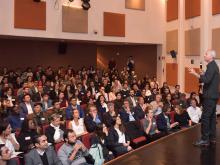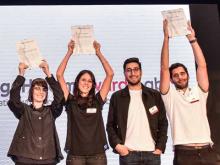The Mexico, Niger and USA-based winning projects of the Global
The projects at the pinnacle of the world’s most significant competition for sustainable design were selected from more than 5,000 submissions to be implemented in 131 countries. “Both Gold and Silver are masterful illustrations of what sustainable design in construction can achieve; and Bronze is a community-driven initiative that opens a new path,” said Alejandro Aravena (Chile), head of the jury of the Global LafargeHolcim Awards.
The level of interest in the competition by young professionals and students has continued to grow. Roland Köhler, chairman of the Board of the LafargeHolcim Foundation, emphasised that more than half of all entries were submitted by individuals and teams with authors aged 18-30 years. “It is exciting that the Awards competition has been embraced by ‘rising stars’; especially that so many Next Generation winners joined the Awards Lab at IBERO here in Mexico City to network and submit proposals for our Research in Practice Grants,” said Köhler.
The LafargeHolcim Awards competition also enjoys a strong level of participation and success by female professionals and students. Maria Atkinson, founding CEO of the Green Building Council of Australia and member of the Board of the Foundation, noted that as diverse as the top winning projects are, the design teams were all led by women. “The Board is delighted by the strong representation and success of women in the LafargeHolcim Awards,” said Atkinson.
The Global LafargeHolcim Awards 2018 winners were:
Gold – Sustainable and decentralised water management in Mexico City
A project team led by architect Loreta Castro of Taller Capital and researcher Manuel Perló from Universidad Nacional Autónoma de México created urgently needed water infrastructure in the eastern periphery of Mexico City. ‘La Quebradora Hydraulic Park’ is nearing completion and improves conditions in the dense urban fabric of the city by forming a greenbelt that doubles as water management infrastructure.
Enrique Norten, Principal of TEN Arquitectos (USA/Mexico) and member of the Board of the LafargeHolcim Foundation, explained that the project strengthens the social fabric of the community by integrating green courtyards and public buildings into urban infrastructure. “The project demonstrates a comprehensive understanding of the issues involved, from construction detailing to long-term maintenance after completion. This infrastructure is given a parallel life as a civic space that functions on many scales,” said Norten.
Silver – Creating a place for all in a community in Niger
The Silver winning project is a religious and secular complex in Niger that reinterprets traditional local construction for a new mosque and a community center. The “Legacy Restored” project was designed by architects Yasaman Esmaili of Studio Chahar (Iran) and Mariam Kamara of Atelier Masomi (Niger). Stuart Smith, director of Arup and member of the jury, explained how the project creates a civic space open to all in the village of Dandaji, supporting the education of women and strengthening their presence within the community. “The design strategy champions local artisanship, traditional building techniques and sustainable materials produced on site,” said Smith.
Bronze – Energy, food and civic engagement in Detroit, USA
The community-driven neighbourhood planning project ‘Seebaldt Street’ won Bronze for re-imagining empty lots as collective infrastructure for energy and food production as well as for civic engagement in Detroit, USA. Marc Angélil, professor of Architecture & Design at the Swiss Federal Institute of Technology (
Guests of the Awards ceremony visited the construction site of the Gold winning project, “La Quebradora Hydraulic Park”. In addition, they were introduced to Mexico City’s new International Airport. Designed by architects Lord Norman Foster and Fernando Romero, it will be the world’s most sustainable airport, serving 68 million passengers per year. Holcim Mexico supplies environmentally friendly, high-performance concretes with sulphate-resistant cement to ensure structural integrity of the applications, and tackling the high concentration of salts on site.







